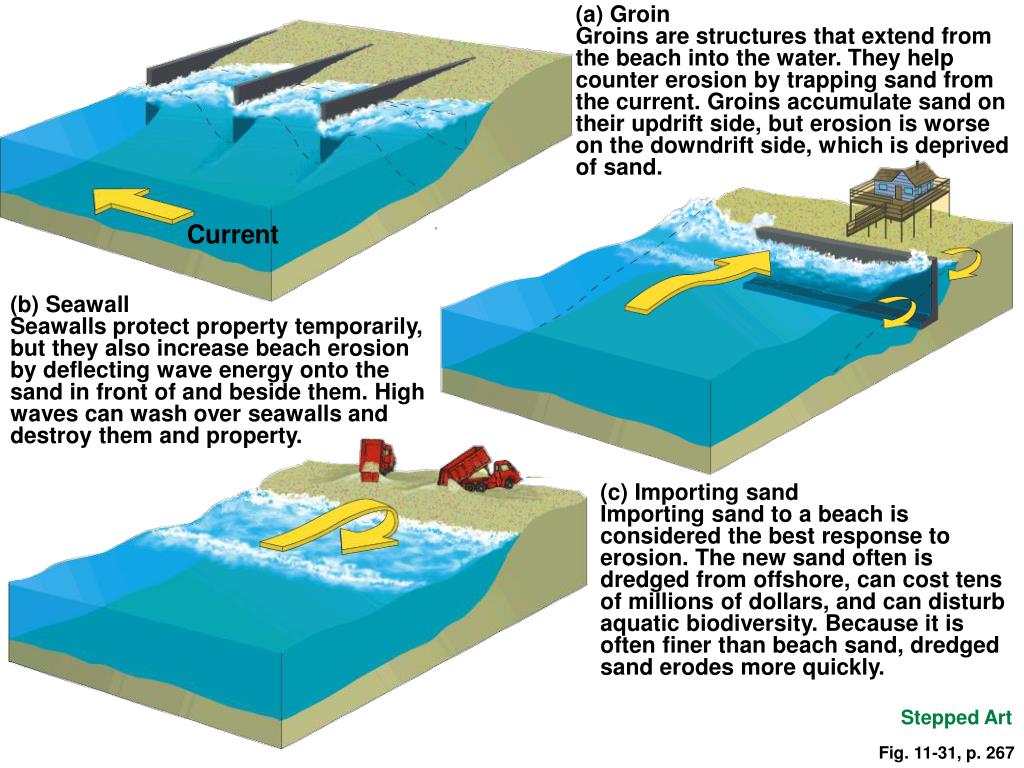

- #Breakwaters seawalls and groins are all examples of manual
- #Breakwaters seawalls and groins are all examples of series
ĭifferent designs of man-made tsunami barriers include building reefs and forests to above-ground and submerged seawalls. Seawalls may also accelerate erosion of adjacent, unprotected coastal areas by affecting the littoral drift process. Wave reflection from the wall may result in hydrodynamic scour and subsequent lowering of the sand level of the fronting beach. Types Ī seawall works by reflecting incident wave energy back into the sea, thus reducing the energy available to cause erosion. The type of material used for construction is hypothesized to affect the settlement of coastal organisms, although the precise mechanism has yet to be identified. In the UK, seawall also refers to an earthen bank used to create a polder, or a dike construction. Other possible construction materials include vinyl, wood, aluminum, fiberglass composite, and biodegradable sandbags made of jute and coir. Seawalls are constructed from various materials, most commonly reinforced concrete, boulders, steel, or gabions.

Combined with a high construction cost, this has led to an increasing use of other soft engineering coastal management options such as beach replenishment. Various environmental issues may arise from the construction of a seawall, including the disruption of sediment movement and transport patterns. Seawalls are hard engineering shore-based structures which protect the coast from erosion. Seawall designs factor in local climate, coastal position, wave regime (determined by wave characteristics and effectors), and value (morphological characteristics) of landform. As a seawall is a static feature it will conflict with the dynamic nature of the coast and impede the exchange of sediment between land and sea. The purpose of a seawall is to protect areas of human habitation, conservation and leisure activities from the action of tides, waves, or tsunamis. Wiegel RL (2002c) Seawalls, seacliffs, beachrock: what beach effects? Part 3.A seawall (or sea wall) is a form of coastal defense constructed where the sea, and associated coastal processes, impact directly upon the landforms of the coast. Wiegel RL (2002b) Seawalls, seacliffs, beachrock: what beach effects? Part 2. Wiegel RL (2002a) Seawalls, seacliffs, beachrock: what beach effects? Part 1. Silvester R, Hsu JRC (1993) Coastal stabilization: innovative concepts. US Army Engineer Waterways Experiment Station, Technical Report, CERC-90-15, Vicksburg Rosati JD (1990) Functional design of breakwaters for shore protection: empirical methods.

In: Proceedings of the 20th coastal engineering conference, ASCE, pp 2144–2158 Pope J, Dean JL (1986) Development of design criteria for segmented breakwaters. In: Proceedings of the 23rd coastal engineering conference, ASCE, pp 3357–3370 Nersesian GK, Kraus NC, Carson FC (1992) Functioning of Groins at Westhampton Beach, Long Island, New York. In: Proceedings of the coastal sediments 91, ASCE, pp 2000–2011 McLellan TN, Kraus NC (1991) Design guidance for nearshore berm construction. National Research Council, The National Academies Press, Washington, DC Marine Board (1995) Beach nourishment and protection, committee on beach nourishment and protection. In: Proceedings of the 24th coastal engineering conference, ASCE, pp 1327–1342 Kraus NC, Hanson H, Blomgren S (1994) Modern functional design of groins. Kraus NC, Pilkey OH (1988) The effects of seawalls on the beach. Kraus NC, McDougal WG (1996) The effects of seawalls on the beach: part I, an updated literature review. In: Proceedings of the 14th annual national conference on beach preservation technology, Florida Shore & Beach Preservation Association, Tallahassee, pp 62–80 Kraus NC, Galgano FA (2001) Beach erosional hot spots: types, causes, and solutions. Kraus NC (2000) Groin notching – an innovative and effective concept. Komar PD (1998) Beach processes and sedimentation, 2nd edn. In: Proceedings of the coastal sediments 03, ASCE, pp 828–843 Hardaway CS, Gunn JR (1999) Chesapeake Bay: design and early performance of three headland breakwater systems. In: Proceedings of the 22nd coastal engineering conference, ASCE, pp 2034–2046 Hanson H, Kraus NC (1990) Shoreline response to a single transmissive detached breakwater. In: Proceedings of the coastal sediments 91, ASCE, pp 1985–1990 Hands EB, Allison MC (1991) Mound migration in deeper water and methods of categorizing active and stable depths. World Scientific Press, 420 ppĭean RG, Dalrymple RA (2002) Coastal processes with engineering applications.
#Breakwaters seawalls and groins are all examples of series
Advanced series on ocean engineering, vol 18.
#Breakwaters seawalls and groins are all examples of manual
Coastal Engineering Manual (2003) Part V, Chapter 3, Shore protection projects, US Army Corps of Engineers, EM 00ĭean RG (2003) Beach nourishment: theory and practice.


 0 kommentar(er)
0 kommentar(er)
